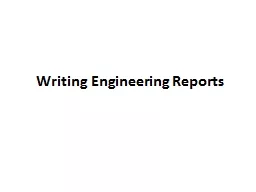

Writing Engineering Reports Overview This presentation will cover Report format and organization Visual design Language Source documentation Courtesy Purdue Writing Lab Report Format and Organization ID: 762531
Download Presentation The PPT/PDF document "Writing Engineering Reports Overview Thi..." is the property of its rightful owner. Permission is granted to download and print the materials on this web site for personal, non-commercial use only, and to display it on your personal computer provided you do not modify the materials and that you retain all copyright notices contained in the materials. By downloading content from our website, you accept the terms of this agreement.
Writing Engineering Reports
Overview This presentation will cover: Report format and organization Visual designLanguageSource documentation Courtesy: Purdue Writing Lab
Report Format and Organization Report generally include these sections in this order: Abstract Introduction/ObjectiveBackgroundMethodology/ProcedureResultsDiscussionConclusionRecommendations
Report Format and Organization Abstract/Executive Summary Always comes first Is brief (one paragraph-one page)Past tenseContent:States research problem or main objectiveIndicate the methodology usedPresents the main findings and conclusions
Report Format and Organization Abstract Example: Surface modification of aluminum powders for the purpose of flow improvement was performed and several samples were prepared. Correlations between the flowability and reactivity for these powders as well as for the initial untreated aluminum powder were established. The powders were characterized using Scanning Electron Microscope (SEM), particle size distribution, angle of repose flowability test, Constant Volume Explosion (CVE) combustion test, and Thermo-Gravimetric Analysis (TGA). The surface modification of micron-sized aluminum powders was done by: (1) dry coating nano-particles of silica, titania and carbon black onto the surface of spherical aluminum powders and (2) chemically and physically altering the surface properties of the same powders with methyltrichlorosilane. All surface modifications improved flowability of the powders. CVE measurements indicate that powders with an improved flowability exhibit improved combustion characteristics if the powder treatment does not add an inert component to aluminum. The TGA results do not show significant differences in the reactivity of various powders. Based on combined flowability and CVE characteristics, the silane modified material gave the best results followed by the powders dry coated with carbon, titania and silica, respectively. Source: “The Effects of Surface Modification of Aluminum Powder on its Flowability, Combustion, and Reactivity” Powder Technology
Report Format and Organization Introduction/Objective Explains the research problem and its context Explains importance of the problem (why does it matter?)Applications of the experiment or theoryExplains reason and goals for studyMotivation Courtesy: Purdue Writing Lab
Report Format and Organization Background Includes the theory for the experiments Any equations required for the calculationsEach equation should be numbersIncluded references Courtesy: Purdue Writing Lab
Methodology/Procedure Is in past tense and passive voice (3 rd person)Do not use “We”, “I”, or “You”Describes the experimental procedure and data collectionIncluded a schematic/diagram of the apparatusWrite in complete sentence“The tank was filled with 5 L of water”NOT “Fill tank with 5L of water”Incomplete sentence and present tense Report Format and Organization Courtesy: Purdue Writing Lab
Results State the results in the text before presenting any graphs, figures or tables. Text points out the most significant portions of research findings Indicates key trends or relationshipsHighlights expected and/or unexpected findingsVisual representation of results:Graphs, tables or figuresIncluded error analysisPast tense (these are results you measured, calculated or observed ) Report Format and Organization Courtesy: Purdue Writing Lab
DiscussionWhy did you observed what you observed? Explanation for Results: Comments on unexpected results, offering hypothesis for them Comparison to literatureDoes your research confirm previous studies? Deviate from them?Report Format and Organization Courtesy: Purdue Writing Lab
Conclusion Discusses: What was learned through research Strengths and weakness of studyPossible applications of study (how it can be used)RecommendationsRecommendationWhat would you do differently?Any changes would you recommend for the experiment Report Format and Organization Courtesy: Purdue Writing Lab
Visual Design Graphics Should be used to illustrate specific points Should be incorporated in a way that is natural to report’s content/contextShould be explained fully in text using references such as “Fig. 1 shows….” Should be cited if taken from a sourceTextual information should come before graphics Courtesy: Purdue Writing Lab
Visual Design Material Density (g/ml) Mean Particle Size Function Aluminum H-5 batch 1 2.70 9.44 um Host Aluminum H-5 batch 2 2.70 9.09 um Host Silica 2.65 20 nm Guest Carbon black 2.00 50 nm Guest Titania 4.23 21 nm Guest Table 1 : Properties of the Raw Materials
Visual Design Figure 1: show the mean particle size of uncoated and surface modified Micronized APAP as a function of dispersion pressure. The plot shows the effects of magnet ratio on attrition.
Visual Design Figure 6.6: The relationship between the AOR and basicity/acidity ratio of the surface of the particles. The plot indicates that the more basic the surface of the aluminum powders, the lower the angle of repose which may correlate to better flowability. Note that the abscissa is plotted in a descending order so as to show the similarity with Figure 6.4.
Reports should be easily accessible Be straightforward and concise Use simple terms, not jargon Keep sentences short and simple (20 words max)No common phases (be technical)“in the ballpark”Be specific and not generalNot “close” or “like” or “pretty” or “roughly”Language and Vocabulary Courtesy: Purdue Writing Lab
Source Documentation Cite sources whenever you are quoting, paraphrasing, or summarizing work that is not your own Quote directly is discouraged DO NOT COPYSources include:BooksJournal, magazine, or newspaper articlesInterviewsConference ProceedingsLectures Courtesy: Purdue Writing Lab
Source Documentation Citing Shows your credibility as a researcher Gives proper credit to authors and researchersProtects you from accusations of plagiarism Courtesy: Purdue Writing Lab
References Courtesy: Purdue Writing Lab Asian Institute of Technology Language Center. (2003). Writing Up Research Guidebook. Asian Institute of Technology. Retrieved June 9, 2005 from http://www.clet.ait.ac.th/el21open.htm Chan, S.L., Kitipornchai , S., and Al- Bermani , F.G.A. (1991). Elasto -plastic analysis of box-beam-columns including local buckling effects. Journal of Structural Engineering , 117, 1946-1978. Halligan , N. (2004). A short course on writing technical reports. Technical Writing. Retrieved June 9, 2005 from http://www.technical-writing-course.com/type-of-technical-report.html Kvam , E. (Personal communication, June 11 2005).